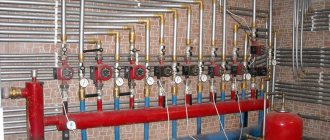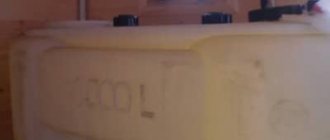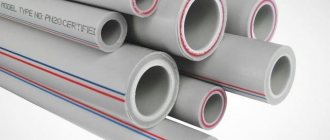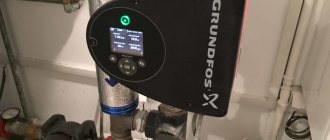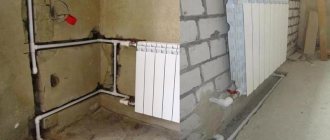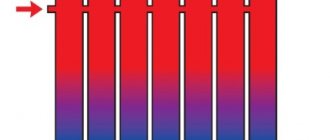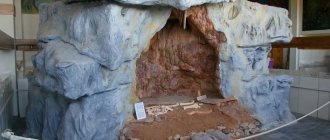Closed heating system - what is it?
As you know, any heating system in a private home has an expansion tank. This is a container that contains some coolant removal. This tank is necessary to compensate for thermal expansion under various operating conditions. By design, expansion tanks are of open and closed type, respectively, and heating systems are called open and closed.
Closed two-pipe heating system
In recent years, a closed heating scheme has become increasingly popular. Firstly, it is automated and works without human intervention for a long time. Secondly, it can use any type of coolant, including antifreeze (it evaporates from open tanks). Thirdly, the pressure is maintained constant, which allows the use of any household appliances in a private home. There are several more advantages that relate to wiring and operation:
- There is no direct contact of the coolant with air, therefore, there is no (or almost no) unbound oxygen, which is a powerful oxidizing agent. This means that the heating elements will not oxidize, which will increase their service life.
- A closed-type expansion tank is placed anywhere, usually close to the boiler (wall-mounted gas boilers come immediately with expansion tanks). An open-type tank should be located in the attic, and this means additional pipes, as well as insulation measures so that heat does not “leak” through the roof.
- The closed type system has automatic air vents, so there is no airing.
In general, a closed heating system is considered more convenient. Its main drawback is its energy dependence. The movement of the coolant is ensured by a circulation pump (forced circulation), and it does not work without electricity. It is possible to organize natural circulation in closed systems, but it is difficult - it requires regulating the flow using the thickness of the pipes. This is a rather complicated calculation, which is why it is often believed that a closed heating system only works with a pump.
To reduce energy dependence and increase heating reliability, install uninterruptible power supplies with batteries and/or small generators that will provide emergency power supply.
Advantages and disadvantages of a closed heating system
- First of all, the coolant does not evaporate. This gives one important advantage - you can use not only water, but also antifreeze. Therefore, the possibility of the system freezing during forced breaks in its operation is eliminated, for example, if it is necessary to leave the house for a long time in the winter.
- The compensation tank can be located almost anywhere in the system. Usually a place is provided for it right in the boiler room, in close proximity to the heating device. This ensures the compactness of the system. An open-type expansion tank is often located at the highest point - in an unheated attic, which will require its mandatory thermal insulation. In a closed system, this problem does not exist.
- Forced circulation in a closed-type system ensures heating of the premises much faster from the moment the boiler is started. There is no unnecessary loss of thermal energy in the area of the expansion tank.
- The system is flexible - you can adjust the heating temperature in each specific room, and selectively turn off some sections of the general circuit.
- There is no such significant difference in the temperature of the coolant at the inlet and outlet - and this significantly increases the time of trouble-free operation of the equipment.
- For heating distribution, pipes of a much smaller diameter can be used than in an open system with natural circulation without any loss of heating efficiency. And this is both a significant simplification of installation work and significant savings in material resources.
- The system is sealed, and if it is filled correctly and the valve system is functioning normally, there should simply be no air in it. This will prevent the appearance of air pockets in pipelines and radiators. In addition, the lack of access to oxygen contained in the air prevents corrosion processes from actively developing.
- You can also include “warm floors” in a closed heating system
- The system is highly versatile: in addition to conventional heating radiators, it can be connected to water-based “warm floors” or convectors hidden in the floor surface. A water heating circuit for domestic needs is easily connected to such a heating system - through an indirect heating boiler.
There are few disadvantages to a closed heating system:
- The expansion compensation tank must have a volume larger than with an open system - this is due to the peculiarity of its internal design.
- It will be necessary to install a so-called “safety group” - a system of safety valves.
- The correct operation of a closed forced-circulation heating system depends on the continuity of the electrical supply. It is possible, of course, to provide, as with the open type, a switch to natural circulation, but this will require a completely different arrangement of pipes, which can reduce a number of the main advantages of the system to zero (for example, the use of “warm floors” is completely eliminated). In addition, the heating efficiency will sharply decrease. Therefore, if natural circulation can be considered, it is only as an “emergency” one, but most often a closed system is planned and installed specifically for the use of a circulation pump.
Components and their purpose
Composition of a closed heating system
In general, a closed heating system consists of a certain set of elements:
- Boiler with safety group. There are two options here. The first is that the safety group is built into the boiler (gas wall-mounted boilers, pellet boilers and some solid fuel gas generators). The second is that there is no safety group in the boiler, then it is installed at the outlet in the supply pipeline.
- Pipes, radiators, water heated floors, convectors.
- Circulation pump. Ensures the movement of coolant. It is installed mainly on the return pipeline (the temperature is lower here and there are fewer possibilities of overheating).
- Expansion tank. Compensates for changes in coolant volume, maintaining stable pressure.
Now in more detail about each element.
Features of an open heating system and a closed one
When starting an open-type heating system, the functionality of all structural elements should be checked. First of all, it is necessary to ensure uninterrupted operation of the pump. After all, it is he who ensures the circulation of coolant in the system. The main advantage of this type of heating is the ability to install additional structural elements.
Closed heating system - the circuit is placed in the public domain. However, you should not carry out work without preliminary calculations. This also applies to the open type of heating of the house. It is worth noting that a do-it-yourself closed heating system has more advantages than disadvantages.
In an open design, contact of the coolant and the atmosphere is undesirable. Unfortunately, this cannot be avoided. As a result, air appears in the pipeline.
This leads to an acceleration of the corrosion process of all metal elements in the heating system. A do-it-yourself closed heating system is isolated from air penetration.
Boiler - which one to choose
Since the closed heating system of a private house can operate autonomously, it makes sense to install a heating boiler with automation. In this case, having configured the parameters, you do not need to return to this. All modes are supported without human intervention.
The most convenient gas boilers in this regard. They have the ability to connect a room thermostat. The temperature set on it is maintained with an accuracy of one degree. It dropped by a degree, the boiler turned on, heating the house. As soon as the thermostat is activated (the temperature is reached), the operation stops. Comfortable, convenient, economical.
Some models have the ability to connect weather-dependent automation - these are external sensors. Based on their readings, the boiler adjusts the power of the burners. Gas boilers in closed heating systems are good equipment that can provide comfort. The only pity is that gas is not available everywhere.
Two-pipe closed heating system in a house on two floors (diagram)
Electric boilers can provide a no less degree of automation. In addition to traditional units, induction and electrode units have recently appeared on heating elements. They are distinguished by their compact size and low inertia. Many believe that they are more economical than boilers using heating elements. But even this type of heating unit cannot be used everywhere, since power outages in winter are a common occurrence in many regions of our country. And provide the boiler with electricity. 8-12 kW from the generator is a very difficult matter.
Solid or liquid fuel boilers are more versatile and independent in this regard. An important point: to install a liquid fuel boiler, a separate room is required - this is a requirement of the fire service. Solid fuel boilers can be installed in the house, but this is inconvenient, since a lot of debris falls from the fuel during combustion.
Modern solid fuel boilers, although they remain periodic equipment (they warm up during combustion and cool down when the fuel burns out), but they also have automation that allows you to maintain a given temperature in the system, regulating the intensity of combustion. Although the degree of automation is not as high as that of gas or electric boilers, it is there.
Example of a closed heating system with an induction boiler
Pellet boilers are not very common in our country. In fact, this is also solid fuel, but boilers of this type operate in continuous mode. Pellets are automatically fed into the firebox (until the stock in the burner is finished). If the fuel quality is good, ash cleaning is required once every few weeks, and all operating parameters are controlled automatically. The only thing holding back the spread of this equipment is its high price: the manufacturers are mainly European, and their prices are corresponding.
A little about calculating boiler power for closed-type heating systems. It is determined according to the general principle: per 10 sq. meters of area with normal insulation take 1 kW of boiler power. It’s just not recommended to take it “back to back”. First, there are unusually cold periods during which you may not have enough rated power. Secondly, working at the power limit leads to rapid wear of the equipment. Therefore, it is advisable to take the boiler power for the system with a margin of 30-50%.
Security group
A safety group is placed on the supply pipeline at the outlet of the boiler. She must control its operation and system parameters. Consists of a pressure gauge, automatic air vent and safety valve.
The boiler safety group is placed on the supply pipeline before the first branch
The pressure gauge makes it possible to control the pressure in the system. According to recommendations, it should be in the range of 1.5-3 Bar (in one-story houses it is 1.5-2 Bar, in two-story houses it is up to 3 Bar). If you deviate from these parameters, appropriate measures must be taken. If the pressure drops below normal, you need to check if there are any leaks, and then add some coolant to the system. At increased pressure, everything is somewhat more complicated: it is necessary to check in what mode the boiler is operating, whether it has overheated the coolant. The operation of the circulation pump, the correct operation of the pressure gauge and the safety valve are also checked. It is he who must discharge excess coolant when the threshold pressure value is exceeded. A pipe/hose is connected to the free branch pipe of the safety valve, which is discharged into the sewer or drainage system. Here it is better to do it in such a way that it is possible to control whether the valve works - if water is discharged frequently, you need to look for the reasons and eliminate them.
Security group composition
The third element of the group is an automatic air vent. Air trapped in the system is removed through it. A very convenient device that allows you to get rid of the problem of air locks in the system.
Security groups are sold assembled (pictured above), or you can buy all the devices separately and connect them using the same pipes that were used to wire the system.
Pressing the heating system
Pressing the heating system
Before filling the heating system with coolant, it is necessary to check the tightness of all joints and connections. To do this, pressing is performed - creating excess pressure in the pipes, i.e. a situation of destabilization of the system is artificially created.
This can be done in two ways - using air injection or coolant. This must be done before the heating system of the double-circuit boiler is filled. This procedure can be carried out using a mechanical (electric) pump or by connecting the water supply. The last option is not recommended, since it will be very difficult to control the process. The order of execution is as follows:
- Preliminary visual inspection of joints and connecting nodes;
- Connecting the mechanism to the inlet pipe of the system;
- Creation of excess pressure, the value of which should exceed the norm by 1.5 times.
The condition of the heating elements must be checked. If a leak occurs, the process stops immediately and can only begin when the defect is repaired.
Expansion tank for closed heating system
The expansion tank is designed to compensate for changes in coolant volume depending on temperature. In closed heating systems, this is a sealed container divided into two parts by an elastic membrane. At the top there is air or inert gas (in expensive models). While the coolant temperature is low, the tank remains empty, the membrane is straightened (picture on the right).
Operating principle of a membrane expansion tank
When heated, the coolant increases in volume, its excess rises into the tank, pushing back the membrane and compressing the gas pumped into the upper part (in the picture on the left). This is displayed on the pressure gauge as an increase in pressure and can serve as a signal to reduce the combustion intensity. Some models have a safety valve that releases excess air/gas when a threshold pressure is reached.
As the coolant cools, the pressure in the upper part of the tank squeezes the coolant out of the container into the system, and the pressure gauge readings return to normal. That's the whole principle of operation of a membrane-type expansion tank. By the way, there are two types of membranes - disc-shaped and pear-shaped. The shape of the membrane does not affect the operating principle in any way.
Types of membranes for expansion tanks in closed systems
Volume calculation
According to generally accepted standards, the volume of the expansion tank should be 10% of the total coolant volume. This means that you must calculate how much water will fit in the pipes and radiators of your system (it is in the technical data for radiators, and the volume of the pipes can be calculated). 1/10 of this figure will be the volume of the required expansion tank. But this figure is only valid if the coolant is water. If non-freezing liquid is used, the tank size is increased by 50% of the calculated volume.
Here is an example of calculating the volume of a membrane tank for a closed heating system:
- the volume of the heating system is 28 liters;
- expansion tank size for a system filled with water 2.8 liters;
- the size of the membrane tank for a system with non-freezing liquid is 2.8 + 0.5 * 2.8 = 4.2 liters.
When purchasing, select the nearest larger volume. Don't take less - it's better to have a small supply.
What to look for when purchasing
There are red and blue cans in stores. Red tanks are suitable for heating. The blue ones are structurally the same, only they are designed for cold water and cannot tolerate high temperatures.
What else should you pay attention to? There are two types of tanks - with a replaceable membrane (they are also called flanged) and with a non-replaceable one. The second option is cheaper, and significantly, but if the membrane is damaged, you will have to buy the whole thing. For flanged models, only the membrane is purchased.
Place for installing a membrane type expansion tank
Usually they place an expansion tank on the return pipeline in front of the circulation pump (if you look in the direction of flow of the coolant). A tee is installed in the pipeline, a small section of pipe is connected to one part of it, and an expander is connected to it through fittings. It is better to place it at some distance from the pump so that pressure differences are not created. An important point is that the piping section of the membrane tank must be straight.
Installation diagram of an expansion tank for membrane-type heating
A ball valve is installed after the tee. It is necessary to be able to remove the tank without draining the coolant. It is more convenient to connect the container itself using an American nut. This again makes installation/disassembly easier.
Please note that some boilers have an expansion tank. If its volume is sufficient, installing a second one is not required.
The empty device does not weigh much, but when filled with water it has a significant mass. Therefore, it is necessary to provide a method of mounting on the wall or additional supports.
The heating expansion tank can be hung on a bracket
Make a support platform
The tank on legs can be installed on the floor
Classification of heating systems
To properly fill a water heating system. you need to know what type it is. There is a classification of systems according to the method of pipe routing: from the top, from the bottom, horizontal, vertical or combined. According to the method of connecting devices using pipes, systems are divided into: single-pipe and double-pipe.
Also, water can circulate in the system naturally or forcefully (if a pump is used). Based on the scale of operation, local and central heating systems are distinguished. As the water moves in the pipes, there are dead-end and passing pipes. All these types are used in mixed order in everyday life.
Circulation pump
The circulation pump ensures the operation of the closed heating system. Its power depends on many factors: the material and diameter of the pipes, the number and type of radiators, the presence of shut-off and thermostatic valves, the length of the pipes, the operating mode of the equipment, etc. In order not to go into the intricacies of calculating power, the circulation pump can be selected according to the table. Select the nearest larger value for the heated area or the planned thermal power of the system, and find the required characteristics in the corresponding line in the first columns.
You can select the parameters of the circulation pump from the table
In the second column we find the power (how much coolant it can pump in an hour), in the third - the pressure (system resistance) that it is able to overcome.
When choosing a circulation pump in a store, it is advisable not to save money. The entire system depends on its performance. Therefore, it is better not to save money and choose a trusted manufacturer. If you decide to buy unknown equipment, you need to somehow check it for noise levels. This indicator is especially critical if the heating unit is installed in a residential area.
Strapping scheme
As mentioned earlier, circulation pumps are installed mainly on the return pipeline. Previously, this requirement was mandatory, today it is only a wish. The materials used in production can withstand heating up to 90°C, but it’s still better not to take risks.
In systems that can also operate with natural circulation, during installation it is necessary to provide for the ability to remove or replace the pump without the need to drain the coolant, as well as for the possibility of operation without a pump. To do this, a bypass is installed - a workaround through which coolant can flow if necessary. The installation diagram of the circulation pump in this case is shown in the photo below.
Installation of a circulation pump with bypass
In closed systems with forced circulation, a bypass is not needed - without a pump it is inoperative. But two ball valves on both sides and a filter at the inlet are needed. Ball valves make it possible, if necessary, to remove the device for maintenance, repair or replacement. The dirt filter prevents clogging. Sometimes, as an additional element of reliability, a check valve is also installed between the filter and the ball valve, which will prevent the coolant from moving in the opposite direction.
Connection diagram (piping) of a circulation pump to a closed-type heating system
Popular closed system schemes
Wiring in heating blocks exists:
- Radial.
- Two-pipe.
- Single-pipe.
Radial
Each radiator autonomously receives its own portion of the coolant; they are all connected to the same source. The beam arrangement is reliable, easy to install and maintain. The wiring is installed in the floor. Pipes are used with a cross-section of sixteen millimeters. The furthest pipes are used up to 22 mm. The cross-section of the boiler line is 26 mm (DN 20).
Two-pipe
The heated coolant circulates. This model of a closed heating system is the most popular and exists in 80% of properties. A variation of the two-pipe arrangement is the Tichelman loop (passing). In this case, cooled water flows in the same direction along with hot water.
This arrangement is simple and reliable, and it is also very easy to install. In private houses up to 220 sq. meters (2 floors), it is recommended to use pipes DN 16, as well as 20 mm. In this case, the outer diameter is 22 - 25 mm
The Tichelman loop is not easy to install; too many pipes have to be installed and the cost increases for this reason.
Single-pipe
The batteries in a single-pipe closed heating system interact with one main line. It is present around the entire perimeter of the room. The disadvantage of such a system is that remote batteries receive the least amount of thermal energy. Water moves only through this pipe. There is a horizontal single-pipe circuit (the third name is “Leningradka”. There are also vertical models, water is distributed from risers, most often found in low-rise country houses. The optimal number of batteries for such a scheme should not exceed five. If the layout is vertical, the building can be up to three floors high The single-pipe circuit is quite “picky”; it must be configured by a specialist with experience.
